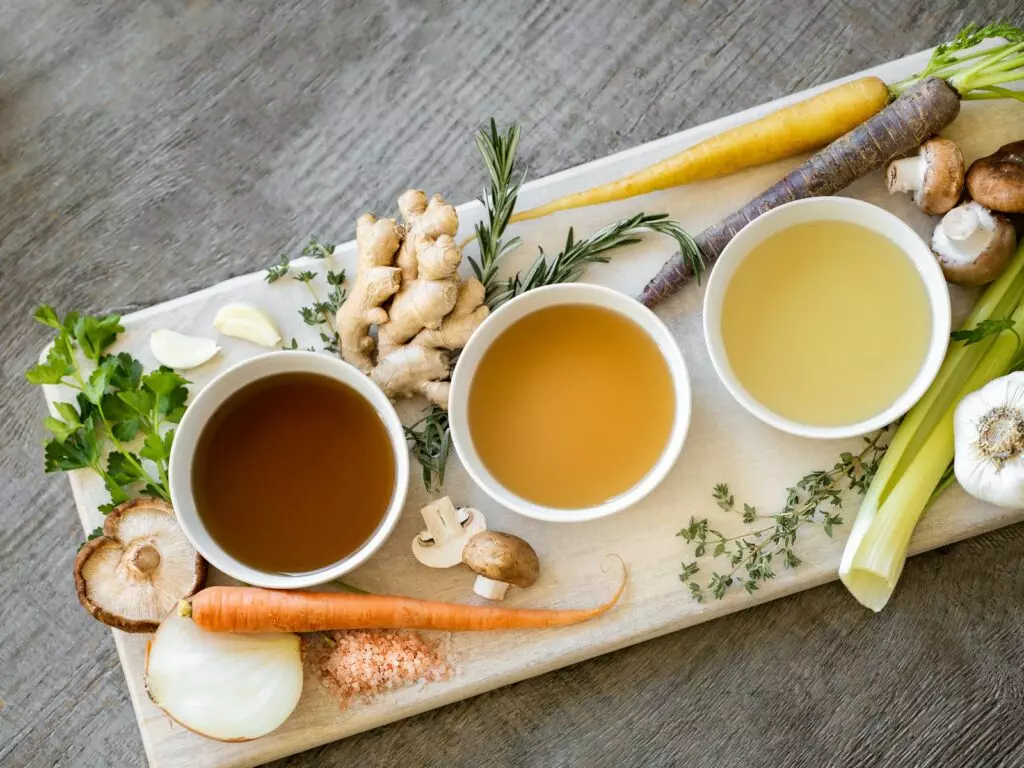Homemade chicken stock is a fundamental ingredient that is used to make so many dishes from soups and stews to sauces, casseroles, and more. Making it from scratch allows you to have control over the flavors and ingredients, and is a great way to save money.
Simmering chicken bones or parts (along with vegetables, herbs and spices you desire) extracts the rich, savory flavor. What you get is nutritious liquid gold to use in the kitchen. The difference it makes compared to store-bought stock is remarkable, and it’s a lot cheaper than buying pre-made stock!
Learning to make your own chicken stock is actually simple and requires minimal active work. You’ll need some basic ingredients like chicken bones—either raw or from a roasted chicken—and water. Everything else, like a mirepoix of onions, carrots, and celery, and herbs can be added for complexity.
By preparing stock at home, not only are you assured of the quality and freshness, but you can also reduce waste by utilizing leftover bones and vegetable scraps.
Notice: This post may contain affiliate links. If you choose to click through and purchase, I may earn a percentage at no extra cost to you.
Key Takeaways
- Homemade chicken stock enhances the flavor of your dishes.
- The preparation involves simmering bones, with optional vegetables, and herbs.
- Homemade chicken stock is more economical than buying from the store.
Essentials of Chicken Stock
At its core, chicken stock is just bones simmered in water. If you’re a new cook, or (like me) really busy, keeping things simple is best. You can add extra ingredients to flavor your stock if you want. But as long as you have bones and water, you’re good to go.
Choosing Your Chicken
You could use a whole chicken, if you want leftover meat for other dishes. I prefer using just bones, like a carcass from a roasted chicken. This enhances the overall body due to the collagen found in the joints and connective tissues.
Required Ingredients
When making chicken stock, your base will always consist of the chicken itself and water:
- Water: Enough to cover your ingredients
- Chicken: A whole chicken, carcass, or parts with bones
If you desire, you may also add:

- Mirepoix:
- 2 onions
- 3 carrots
- 3 celery stalks
- Salt: Generously season to taste
- Herbs and Spices: Parsley, thyme, bay leaves, or black peppercorns
- Vinegar: A small splash or white vinegar or apple cider vinegar will help draw out the flavor and nutrients from the bones.
When seasoning your stock, keep in mind the kinds of dishes you plan to use it in. This is one reason I keep mine ultra-simple. When the stock isn’t flavored with any specific spices or seasonings, it can be used in anything.
I choose not to salt my stock for the same reason. It gives me better control of how salty the finished dish is. Remember, you can always add more salt to a dish, but it’s hard to remove it.
I try to remember the vinegar. Just 1-2 tablespoons are enough when I’m making stock from one carcass.
Recommended Equipment
To make prepping your stock a breeze, here’s what you’ll need:
- A large stockpot or Dutch oven: Large enough to hold the chicken, water, and any other ingredients, typically 6 to 8 quarts.
- A fine mesh strainer: Essential for filtering out solids for a clear broth. I’ve used cheesecloth, but it’s messier. Get a strainer instead.
- A large bowl: Large enough to hold the finished stock after the bones and other ingredients have been removed. This is what I strain the stock into.
- Wide mouth funnel: Very handy for pouring the finished stock into jars. I don’t like mess.
- Storage containers: For refrigerating or freezing the finished stock. I prefer quart-sized mason jars.
Cooking Process
Start by gathering chicken bones or parts and cover them with water. Add a splash of vinegar to help extract the flavor and nutrients.
Next, it’s time to add any optional flavors you want. Toss in some roughly chopped onions, carrots, and celery. These veggies add a wonderful depth of flavor to the stock. Season with a pinch of salt, a few cracks of black pepper, and any herbs or spices you like.

This is where you can get creative – throw in some thyme, parsley, or a bay leaf for extra fragrance. Just keep in my what kind of dishes you plan to use the stock for. If you plan to make something like bone broth hot chocolate, I recommend keeping your stock plain.
Now, let everything simmer on the stove for at least 4-6 hours. Start by bringing your pot of chicken bones, vegetables, and aromatics to a slow boil and then reduce the heat to a simmer. A bubble or two every second is what you’re aiming for.
I like to let mine simmer for 12-18 hours. As the stock cooks, your kitchen will be filled with a mouthwatering aroma that will have you eagerly anticipating the end result.
Once the stock has simmered to perfection, it’s time to strain out the solids. I like to use a colander over a large bowl to strain out the large bones (and vegetables if I’ve used them). Then use a fine-mesh strainer or cheesecloth to separate the smaller particles from the liquid.
What you’re left with is a beautiful, golden homemade chicken stock that’s ready to be used in soups, stews, sauces, and so much more. The best part is that you have complete control over the flavors and ingredients, ensuring that your dishes are infused with that special homemade touch.
Straining and Storing
After simmering your chicken bones and vegetables into a rich and nutritious broth, the next steps are straining out the solids and storing your stock for future use. These steps are crucial for a clean, clear broth and long-term preservation.
Straining Techniques

To strain your chicken stock, you have a few options. Fine mesh strainers work well to remove larger solids like bones and vegetable chunks. For an even clearer stock, line the strainer with cheesecloth which can catch even smaller particles. Always pour slowly and be careful to avoid splashes and spills. A funnel is useful to help keep mess minimal.
Personally, I like to keep my process simple and easy, so I usually skip the cheesecloth. The last jar I fill with stock gets those smaller particles, but I’m not bothered by it. If you are, cheesecloth does a great job at removing those last fine particles.
Usage Ideas
When you have a pot of homemade chicken stock, the possibilities in your kitchen expand significantly. It’s a versatile ingredient that can enhance numerous dishes with its rich flavor.
Soups and Sauces
Your chicken stock is the perfect base for comforting soups. For instance, you can use it to prepare a classic chicken noodle soup or a more exotic Thai coconut curry soup. As for sauces, deglazing a pan with chicken stock after searing meat creates a flavorful foundation that you can build upon with herbs and spices for a restaurant-quality finish.
Rice and Grains
Infusing your favorite rice and grains with chicken stock is a simple way to up the ante on flavor. If you’re cooking long-grain rice, simply substituting water with chicken stock can make a world of difference. Whether it’s a lemon cranberry quinoa salad or a hearty risotto, the stock provides a subtle undertone that water just can’t match.
Braising Liquids
For tender and flavorful meats, use your chicken stock as a braising liquid. When you’re slow-cooking short ribs, pork shoulder, or even vegetables, adding chicken stock can impart additional moisture and a rich, meaty flavor that complements your primary ingredients beautifully.
Frequently Asked Questions
Creating homemade chicken stock is a satisfying process that not only enriches your dishes but also helps use leftover ingredients. Here are some common queries answered to help you make the perfect stock.
What are the essential ingredients I need for a flavorful homemade chicken stock?
To create a rich and flavorful chicken stock, you’ll need chicken bones, which can include backs, necks, or a carcass. You can enhance the taste by adding aromatics like onions, carrots, and celery. Herbs like parsley and thyme, along with whole peppercorns, contribute depth, while a bit of acid from a tomato or a splash of vinegar helps extract nutrients from the bones.
Can you guide me through the steps to prepare chicken stock using leftover bones?
Absolutely! Begin by gathering leftover chicken bones, whether from a roasted or boiled chicken, and place them in a large pot. Cover with water and bring to a gentle simmer, adding your choice of vegetables and herbs for flavor. Let this simmer for a few hours, occasionally skimming off any impurities that arise to the surface for a clearer stock.
How can I make a quick chicken stock if I’m short on time?
For a quick stock, focus on high-heat extraction and a shorter simmering time. Use already-cooked chicken bones, add boiling water to accelerate the process, and incorporate intense flavors like onions, garlic, and peppercorns. Simmer for 45 minutes to an hour; while not as complex, it will still add a homemade touch to your dishes.
What’s the difference between chicken stock and broth, and when should I use each?
Chicken stock is typically made with bones and simmered for a longer period, resulting in a rich, gelatinous liquid ideal for sauces and gravies. Broth, on the other hand, is usually made with meat and vegetables, has a lighter flavor and texture, and is perfect for soups and drinking on its own.
How long should I typically simmer my chicken stock to achieve the best flavor?
For a well-developed flavor, simmer your chicken stock for at least four to six hours. This allows enough time for the flavors to meld and for the collagen from chicken bones to enrich the stock, giving it a full-bodied mouthfeel.
Is it okay to use a rotisserie chicken as the base for making stock, and what are the benefits?
Yes, it’s a great idea to use a rotisserie chicken for stock! It adds robust flavor due to the chicken being already cooked and seasoned. Additionally, it’s cost-effective and reduces food waste, making the most out of a single chicken.







